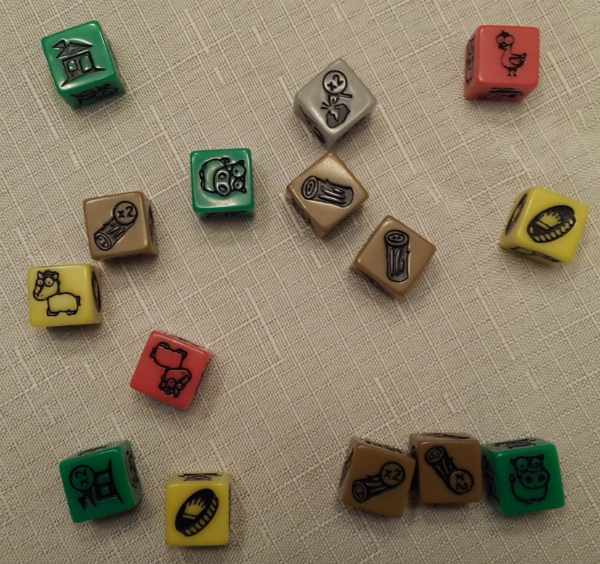Imagine you are standing on a rolling green hillside at some undetermined point in the 13th century. It is a warm spring day, and you are about to break ground on your new home. You envision a glorious and enviable castle, one for the ages. You have the willpower and drive to begin this project as it will span several years. Still, you’re optimistic for a grand result, where your subjects praise you and your enemies fear you…
Ok, now imagine that your castle architect is Gary Gygax.
The Premise
Castle Dice is a race by players to complete the most valuable castle they can. They must be careful though, as resources are limited and pillage-happy Barbarians could be around any corner. Players must balance their right resources as they collect different building materials, helpers, and livestock in order to elevate their castle’s status above all others.
The Rules
Castle Dice is atypical of most dice games, as there are slightly more components than the dice themselves. However, the extra materials do not actually add to the setup time. The dice themselves come in one of the five different basic resources: Wood (Brown), Stone (Grey), Gold (Yellow), Land (Green), and Iron (Red). Additionally, there are three card decks – Castle, Village, and Market. The first two decks comprise the various workers and structures players can build respectively throughout the game, providing abilities and valuable VP.

The power of livestock.
There are also two types of tokens. The first set are the Animal tokens. Possessing the most of certain Animals (Horses, Pigs, Cows, and Chickens) award different bonuses, and sets of them can be turned in for a Market card. The other tokens are Villager tokens, which are used to denote when players build respective units.
To start, each player receives a player board. Castle Dice is played out over seven rounds, and there is a central Turn Tracker board to keep track of what transpires during each round. The rules state that each round is comprised of ten steps, but this is far less intimidating than it first appears.
In each round but the first, the player with the most Horses starts. The first round has players roll Wood dice to see who has the highest number of results (though we say it’s acceptable if one actually owns real horses – or a sizable My Little Pony collection – that one could make a claim here instead of rolling). They are the first to act in each step of that round.
The rounds begins by players discarding any cards from previous rounds they don’t wish to keep and drawing from the Castle and/or Village decks up to a hand limit of five. Each card has a symbol that specifies when it can be played during the round and any requirements to use them.
Next, each player is allocated the dice depicted on the Turn Tracker for that round. Each player is then allowed to choose a number of additional dice of any type equal to the blue dice number. Players then roll; the results will either be resources or a Barbarian. Barbarians represent a player’s territory being raided, and each player keeps any Barbarians rolled.
Unlike most dice rolling games, however, all other dice are pooled together, making up a World Pool of resources for the round. Here, players pick dice one at a time from the World Pool and collect the resources listed until all are allocated. If a player takes a basic resource, the amount is added to the player’s tracker board. If it is an Animal, they add an Animal token of that kind to their board.
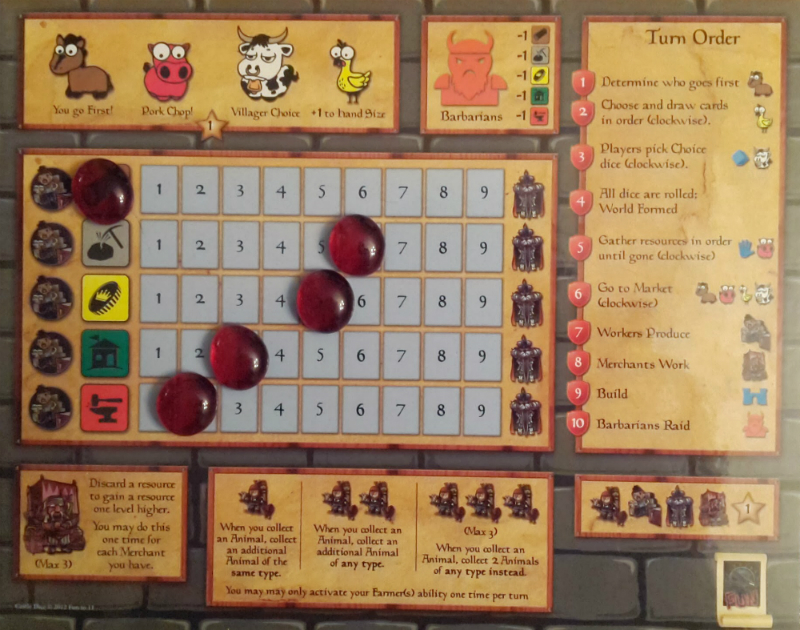
A player board. This player could use some wood…
(Alas, that Settlers joke never gets old.)
Afterwards, players may turn in sets of Animal tokens for Market cards, a pair of Villager abilities are resolved, and then the turn moves into the Build phase. At this point players play cards from their hands if they can afford the requirements.
Lastly, once all players have finished playing cards, the Barbarians come. For each Barbarian a player has, they reduce all of their basic resources stored by one. All dice are then returned, and the game proceeds to the next round.
At the end of the seventh round, players count up Victory Points, comprising mainly of built Castle cards. The player with the most VP is declared the winner, as they have proven themselves to be the most skillful artisan, adept at creating a wondrous castle despite uncertain resource conditions.
Everyone else has gone bankrupt in not achieving victory and must now serve them as serfs.
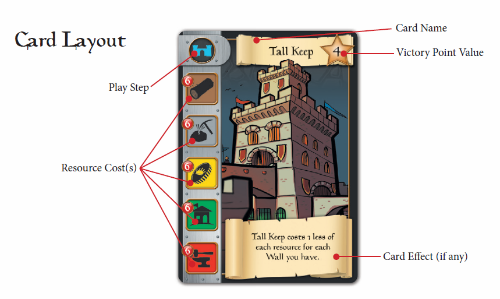
Layout of a Castle Card.
Pooling Ideas
With most dice games, players have their own dice, and then they use the results of those rolls to score points and reach objectives. Whether it’s a classic like Yahtzee, a modern dice game like Quarriors, or pretty much any Press Your Luck game, the premise is the same. And it makes sense really – many people like the sensation of rolling dice. (If they didn’t, you’d never see another Craps table in a casino.) There’s a rush of excitement and trepidation rolled into one when the dice are cast, for once they’ve begun tumbling it’s up to luck to decide the outcome.
As a result, victory in dice games are largely dictated by two major factors, and Castle Dice addresses both. The first is simple luck. Dice are risky, the results unpredictable. Beyond simple success/failure scenarios, it makes planning difficult, and it’s precisely this reason that Strikers generally avoid dice-laden games. They simply don’t like their goals being sidelined by things outside anyone’s control. Castle Dice is no different in this respect – it’s still a dice game after all.
What Castle Dice does instead is help to alleviate the plight of a poor dice roller by having everyone’s dice pooled and drafted. The collective dice pool mechanic is arguably Castle Dice’s strongest attribute. It avoids issues seen in many dice games where your individual results mean you simple can’t do anything. It smooths out the risk/reward curve while not removing the enjoyment people get from their rolls. With Castle Dice, you’re making decisions of which extra dice are included and which resources to take from the pool that will benefit you the most.
Moreover, its strength is further illustrated by the fact that Tacticians – who are usually as skeptical of heavy dice games as Strikers – can still enjoy the game. There’s still enough for them to do to be satisfied. By doing a dice draft from a pool, you’re still accomplishing something each round (or stockpiling for the next), even if what turns up isn’t precisely what you wanted.
The second major factor is fixed resources. If you roll a bunch of six-sided dice and they all come up twos, then you have a bunch of twos to work with. Period. Castle Dice has a number of ways to avoid such bottleneck issues beyond hoping that other players rolled better than you. For one, resources can be stored for later rounds instead of simply working in the here-and-now of only that turn.
The extra dice each round also help, and there are cards to increase the number of dice you use each round. This still comes with risks of course, since the more dice you roll mean the potential for more Barbarians, but its usually worth the gamble. One of the Villager actions and one of the Animal bonuses can assist you further in getting specific resources, not to mention that you can pitch cards at the start of each round you don’t feel are attainable.

Probably not the Warriors Three you had in mind.
I Am Iron Pig!
All of this adds up to make Castle Dice a dice-based Resource Management game that doesn’t feel like one. You rarely feel completely stuck, although setbacks can happen, and there’s enough randomization that you still have that rewarding sensation when you build structures requiring effort.
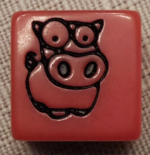
We call him Ozzy.
For Architects, this is the type of dice game they enjoy. It has an easygoing atmosphere for amassing resources, recruiting Villagers and building castle parts. The opposition comes in the form of Barbarian rolls or other players taking the dice you wanted rather than another player messing with your territory directly. What’s more, the Barbarians are even polite enough apparently to wait until after you’ve constructed everything you want before sacking your castle.
Indeed, the game certainly has a bit more complexity than other dice games, but that doesn’t mean it’s complicated. There is some ambiguity with how a few of the cards work from a timing standpoint, but aside from those Castle Dice is actually lighter than it first appears. In many ways it’s like a slightly more advanced version of Settlers of Catan. There is a bit more going on, but it’s still light enough for a casual environment or people of mixed gaming experience. As a result, while it does creep closer to the limit of their complexity tolerance, Castle Dice is still a good choice for Socializers.
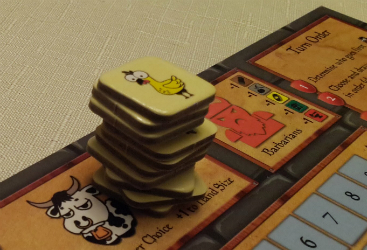
We aren’t sure what the plan is with all those chickens…
On the other hand, you have two other groups with fairly stoic opinions regarding dice games. Daredevils were already intrigued by the word ‘dice’ in Castle Dice, and there’s certainly enough minor strategy for them to proceed in a variety of manners.
Similarly, there’s little here for Immersionists. The game has a good amount of flavor to it, and it pulls that off just fine. The artwork is well done, and the different elements of the game interact with each other handily. That said, as with just about any dice-centric game, there’s little in the way of a truly thematic setting that will entice Immersionists here.
The Takeaway
Castle Dice is a fantastic dice-based Gateway Plus Game. Underneath the surface, it does just boil down to picking dice, rolling them, and then using the results to build things. However, there is more strategy and diversity to it than that, which gives it a fair amount of replayability. Having depth is always important with dice games. Castle Dice has a fun, simple premise, and at a fixed seven turns never drags out. It can be played as quickly or as leisurely as your group prefers while not affecting the enjoyment of the game. It lets players roll dice with a purpose, whether that payoff is in the current round or the next one. The dice pool mechanic is a great idea, helping Castle Dice avoid a lot of the pitfalls and wide disparity that happens with other games of its kind. Aside from a couple cards that could be more clearly worded, it easily succeeds at being a very enjoyable and approachable dice game. For lovers of dice games, or someone seeking an innovate intro-level game, Castle Dice certainly may be a game for you.
Castle Dice is a product of Fun to 11 Games.
Cardboard Republic Snapshot Scoring (Based on scale of 5):
Artwork: 4.5
Rules Clarity: 4.5
Replay Value: 4
Physical Quality: 4.5
Overall Score: 4.5

